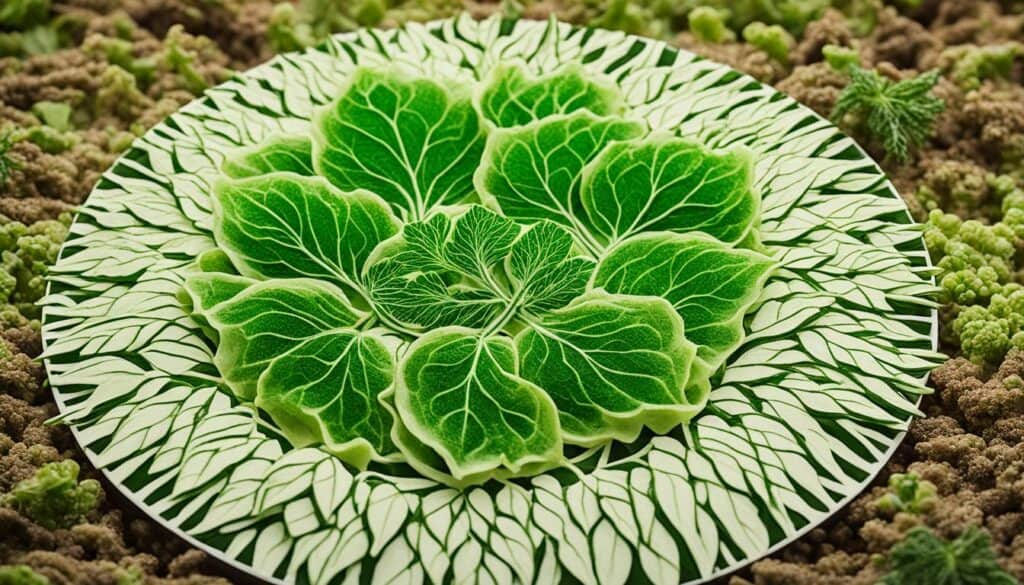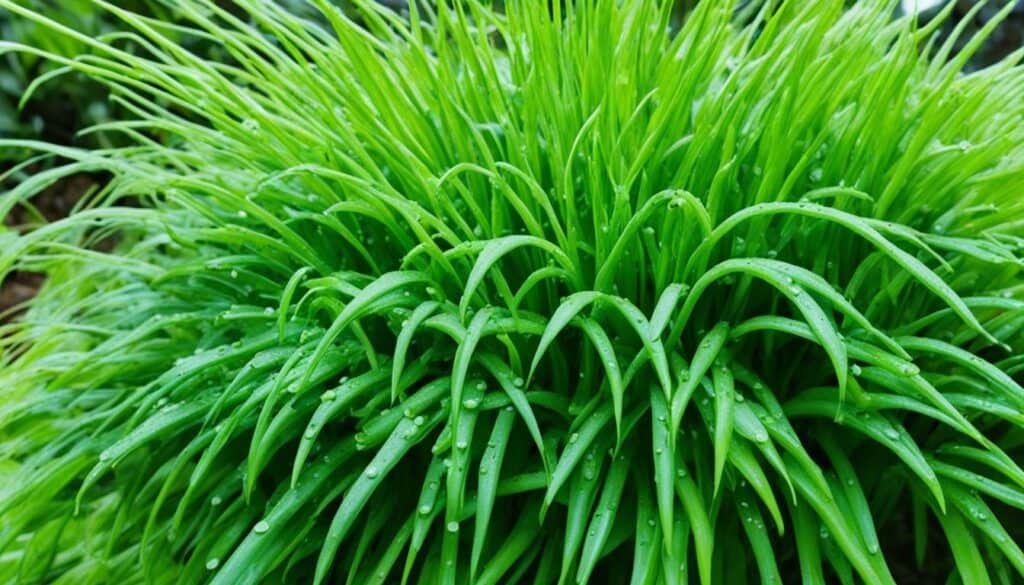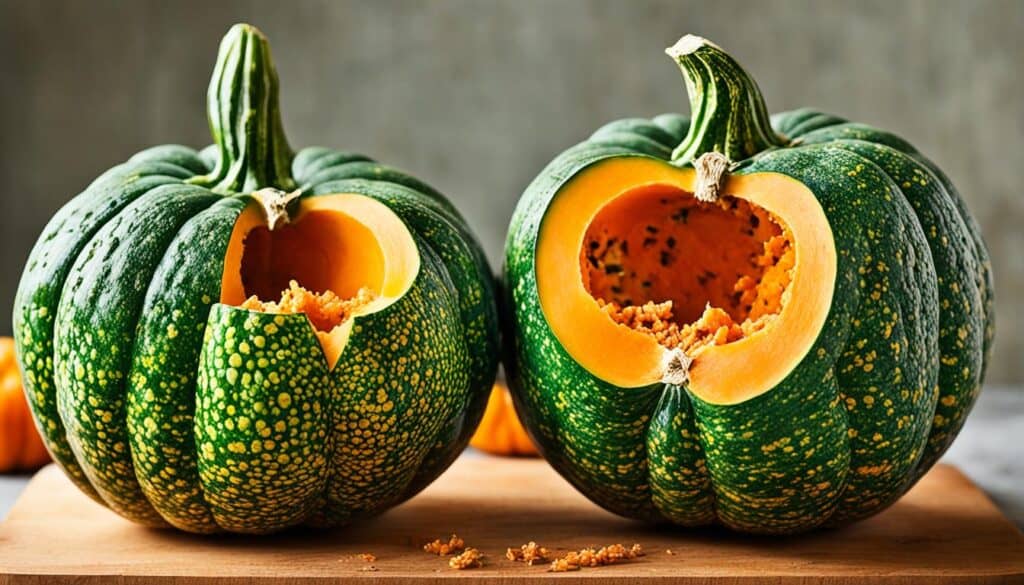Did you know that Japan is home to over 400 varieties of vegetables? From leafy greens to vibrant root vegetables, Japanese cuisine boasts an incredible diversity of plant-based ingredients. These vegetables are not only delicious, but they also offer a range of flavors and textures that are essential to traditional Japanese dishes. Let’s embark on a culinary journey and explore the world of Japanese vegetables and discover how they can elevate your cooking.
Key Takeaways:
- Japan is known for its vast variety of vegetables, offering unique flavors and textures.
- Japanese vegetables are essential ingredients in traditional Japanese cuisine.
- Exploring Japanese vegetables can add depth and complexity to your cooking.
- Try incorporating Japanese vegetables into your recipes for a taste of Japan.
- Japanese vegetables are nutritious and can be enjoyed in different seasonal dishes.
Mizuna (水菜)
When it comes to Japanese vegetables, mizuna is a must-try. Also known as Japanese mustard greens or potherb mustard, mizuna is a leafy green vegetable that offers a unique flavor and texture to various dishes. Its name literally translates to “water greens” in Japanese, highlighting its fresh and vibrant nature.
Mizuna has a distinctive peppery taste with a hint of bitterness, making it a standout ingredient in Japanese cuisine.
This versatile green can be enjoyed raw in salads or cooked in various ways, allowing it to complement a wide range of dishes. From stir-fries to hot pots, soups to pasta dishes, mizuna brings a refreshing and zesty flavor that enhances the overall taste.
If you’re looking to incorporate mizuna into your cooking, here are a few delectable recipes to get you started:
| Mizuna Recipes |
|---|
| Mizuna Salad with Sesame Dressing |
| Mizuna Stir-Fry with Garlic and Ginger |
| Mizuna Hot Pot with Tofu and Shiitake Mushrooms |
| Mizuna Soup with White Miso and Udon Noodles |
| Pasta with Mizuna, Cherry Tomatoes, and Parmesan Cheese |
These recipes showcase the versatility of mizuna, allowing you to experiment and enjoy its unique flavors in different culinary creations.
Komatsuna (小松菜)
In Japanese cuisine, komatsuna, also known as tendergreen or Japanese mustard spinach, is a popular leafy green vegetable. With its long stems and rounded leaves, it adds a refreshing touch to various dishes. When young, komatsuna has a sweet and mild flavor, perfect for salads or lightly sautéed dishes. As it matures, it develops a more fibrous texture and a peppery mustard bite, making it a versatile ingredient that can be used in a range of cooking methods.
“Komatsuna has a sweet and mild flavor when young, perfect for salads or lightly sautéed dishes.”
One of the great advantages of komatsuna is its adaptability to different culinary techniques. It can be stir-fried, blanched, pickled, braised, or added to soups and hot pot dishes. Its tender and crunchy texture adds a pleasant contrast to various preparations, while its subtle mustard notes contribute a unique flavor profile.
If you’re looking for some inspiration, here are a few komatsuna recipe ideas to try:
- Komatsuna Salad: Combine fresh komatsuna leaves with your favorite salad ingredients and dress with a zesty vinaigrette for a refreshing and nutrient-packed salad.
- Komatsuna Stir-Fry: Sauté komatsuna with garlic, ginger, and soy sauce for a quick and delicious side dish that pairs well with rice or noodles.
- Komatsuna Soup: Add blanched komatsuna to a flavorful broth along with other vegetables and protein of your choice for a comforting and nutritious soup.
With its mild and versatile nature, komatsuna is a wonderful addition to any kitchen. Its vibrant green color and delicate flavor can elevate a wide range of dishes, providing both visual appeal and culinary satisfaction. Try experimenting with komatsuna in your own recipes and discover the unique and delightful characteristics this Japanese vegetable has to offer.
Shungiku (春菊)
When it comes to Japanese vegetables, shungiku is a standout ingredient that adds a unique flavor profile to various dishes. Also known as chrysanthemum leaves or edible chrysanthemum, shungiku is a green leafy vegetable that is widely used in Japanese cooking.
One of the remarkable features of shungiku is its grassy and mildly sweet flavor, which adds depth to any dish it is added to. Whether eaten raw in salads or blanched, shungiku brings a fresh and distinct taste to the table.
Shungiku is a versatile ingredient that can be utilized in numerous ways. It is frequently incorporated into stir-fries, soups, and hot pot dishes, adding a delightful crunch and enhancing the overall flavor. For example, it is an essential component in the popular Japanese hot pot dish, sukiyaki.
If you’re looking to incorporate shungiku into your cooking, there are various shungiku recipes to try. From refreshing salads to flavorful stir-fries, the possibilities are endless. Here are a few shungiku recipes to get you started:
- Shungiku Salad with Sesame Dressing: Toss together fresh shungiku leaves with a delicious sesame dressing for a light and nutrient-packed salad.
- Shungiku Stir-Fry with Garlic and Soy Sauce: Sauté shungiku with garlic and soy sauce for a quick and tasty side dish.
- Shungiku Hot Pot with Beef and Tofu: Create a comforting hot pot meal by combining shungiku with succulent beef slices and silky tofu in a flavorful broth.
By experimenting with shungiku in your recipes, you can elevate the flavors of your Japanese dishes and introduce a new level of culinary experience to your meals.
Next, let’s explore another popular Japanese vegetable, hakusai, and discover its culinary uses and benefits.
The Versatility of Shungiku in Japanese Cuisine
One of the remarkable features of shungiku is its grassy and mildly sweet flavor, which adds depth to any dish it is added to.
Shungiku, also known as chrysanthemum leaves or edible chrysanthemum, is a green leafy vegetable that is commonly used in Japanese cuisine. With its grassy and mildly sweet flavor, shungiku brings a unique taste to various dishes. Whether it’s a refreshing salad or a comforting hot pot, shungiku adds a delightful crunch and enhances the overall experience.
Shungiku Recipes
| Recipes | Description |
|---|---|
| Shungiku Salad with Sesame Dressing | Toss together fresh shungiku leaves with a delicious sesame dressing for a light and nutrient-packed salad. |
| Shungiku Stir-Fry with Garlic and Soy Sauce | Sauté shungiku with garlic and soy sauce for a quick and tasty side dish. |
| Shungiku Hot Pot with Beef and Tofu | Create a comforting hot pot meal by combining shungiku with succulent beef slices and silky tofu in a flavorful broth. |
Hakusai (白菜)
Hakusai, also known as Chinese cabbage or napa cabbage, is a leafy green vegetable with densely packed leaves. It has a mild and slightly sweet flavor, making it a versatile ingredient in Japanese cuisine. Whether eaten raw or cooked, hakusai adds a fresh crunch to a variety of dishes.
One popular way to enjoy hakusai is in hot pot dishes, where the cabbage leaves soak up the flavors of the broth and other ingredients. The tender texture of hakusai pairs well with the rich and savory components of hot pot, creating a comforting and flavorful meal.
Hakusai is also a common ingredient in salads, providing a crisp and refreshing element to balance other flavors. Combine it with fresh greens, protein, and a tangy dressing for a wholesome and satisfying salad.
To showcase the versatility of hakusai, here are a few hakusai recipes:
- Hakusai Stir-Fry with Garlic and Ginger
- Hakusai Salad with Sesame Dressing
- Hakusai Kimchi
Experiment with different cooking techniques and flavor combinations to discover your favorite way to enjoy hakusai.
Negi (ネギ)
Negi, also known as long onion or white onion, is an allium with a thick and long white stem and hollow green tops.
It has a spicy and sharp flavor when raw and a sweet flavor when cooked. Negi is often used as a garnish for noodles and rice bowls and is a popular addition to hot pots, miso soup, and yakitori.
Here are some ways to use negi in your dishes:
- Chop negi and sprinkle it on top of your ramen or udon for added flavor and crunch.
- Include negi in your stir-fries to add a kick of spice and freshness.
- Use negi as a topping for yakitori skewers to enhance the aroma and taste.
- Add chopped negi to miso soup for a burst of flavor and visual appeal.
Substitutes for Negi
If you don’t have negi on hand, here are some substitutes you can use:
Scallions: Scallions, also known as green onions, have a milder flavor compared to negi but can still provide a similar onion-like taste.
Leeks: Leeks have a mild and sweet flavor with a subtle onion taste. They can be a good substitute for negi in dishes like soups and stir-fries.
Garlic Chives: Garlic chives have a garlicky flavor and can add a unique twist to your dishes. They can be used as a substitute for negi in various recipes.
| Recipe | Description |
|---|---|
| Negi Miso Soup | A classic Japanese soup made with miso paste, dashi, and negi. It is a comforting and flavorful dish that highlights the natural sweetness of negi. |
| Negi Chicken Yakitori | Skewers of tender chicken pieces grilled with a savory sauce and garnished with grilled negi. It is a popular street food in Japan. |
| Negi Fried Rice | A delicious stir-fried rice dish with negi, vegetables, and protein of your choice. The negi adds a unique flavor and aroma to the dish. |
Edamame (枝豆)
When it comes to Japanese snacks, edamame is a popular choice. These immature soybeans, also known as “branch beans,” offer a delightful combination of flavors – sweet, nutty, and slightly grassy. Prepared by boiling or steaming the pods, edamame is not only delicious but packed with nutrients as well. It’s no wonder they have become a staple in Japanese cuisine.
Edamame can be enjoyed in various ways. As a snack, they are perfect on their own, providing a satisfying crunch and burst of flavor. But their versatility extends beyond snacking. These little beans can be incorporated into a variety of dishes, adding a touch of freshness and nutritional value.
One popular way to enjoy edamame is by mixing them into rice dishes, such as fried rice or sushi rolls. Not only does it add texture and color, but it also increases the protein content of the dish. Edamame can also be added to soups and stews, enhancing the flavor and providing an extra dose of nutrients.
For those looking for a light and refreshing option, edamame can be tossed into salads. The vibrant green color and flavorful taste elevate any salad, while the protein and fiber in the beans keep you feeling satisfied.
Edamame: Nutritional Benefits
Edamame is not only delicious but also a nutritious addition to your diet. These little beans are high in protein, making them an excellent source of plant-based protein for vegetarians and vegans. They also contain a good amount of fiber, which aids in digestion and helps keep you feeling full.
In addition to protein and fiber, edamame is rich in vitamins and minerals. They are a good source of folate, vitamin K, and iron, among others. These nutrients are essential for overall health and can contribute to a balanced diet.
| Nutrient | Amount per 100g |
|---|---|
| Protein | 11g |
| Fiber | 5g |
| Folate | 94μg |
| Vitamin K | 41μg |
| Iron | 2.7mg |
Edamame is not only a tasty snack but also a nutritious choice for incorporating into your meals. With its protein, fiber, and array of vitamins and minerals, it’s a fantastic way to add a healthy boost to your diet.
So, whether you’re looking for a delicious snack or wanting to amp up the nutritional value of your meals, reach for edamame. These “branch beans” are not only a tasty treat but also a powerhouse of nutrients. Incorporate them into your favorite recipes, and experience the delightful flavors they bring to your dishes.
Azuki (小豆)
Azuki, also known as red beans, are legumes with a dark reddish color. These small beans are a staple in Japanese cuisine and are used in a variety of dishes, both sweet and savory. With their nutty and sweet flavor, they add a unique taste and texture to meals.
One popular use of azuki beans is in the creation of anko, a sweet bean paste that is widely used in traditional Japanese confectionery. Anko is made by cooking the beans with sugar until they are soft and mashable, resulting in a smooth and velvety paste. This sweet bean paste is a key ingredient in treats such as dorayaki (a pancake-like confection filled with anko) and taiyaki (a fish-shaped cake filled with anko).
But azuki beans are not limited to sweet dishes. They can also be used in savory recipes such as soups and stews. The beans add a rich flavor and creamy texture to these dishes, making them hearty and satisfying.
For those looking to incorporate azuki beans into their cooking, here are a few recipes to try:
- Azuki Bean Soup: A warm and comforting soup made with azuki beans, vegetables, and savory seasonings.
- Azuki Curry: A tasty twist on traditional curry, with the addition of azuki beans for added flavor and texture.
- Azuki Bean Rice: Cook azuki beans with rice for a fragrant and flavorful side dish that pairs well with a variety of main courses.
With their versatility and delicious taste, azuki beans are a must-have ingredient in any Japanese kitchen. Whether you’re enjoying them in a sweet treat or adding them to a savory dish, azuki beans are sure to bring a unique and satisfying flavor to your meals.
Did You Know?
Azuki beans are also known as red mung beans, though they should not be confused with the larger green mung beans commonly used in Asian cuisine.
Kabocha (南瓜)
Kabocha, also known as Japanese pumpkin, is a versatile winter squash that is a staple ingredient in Japanese cuisine during the fall and winter seasons. It offers a sweet and nutty flavor, reminiscent of sweet potato and chestnut, making it a delightful addition to both savory and sweet dishes.
One of the popular ways to prepare kabocha is by simmering it, which helps enhance its natural sweetness and tender texture. This cooking method allows the flavors to meld together, resulting in a delicious and comforting dish.
Roasting is another fantastic way to enjoy kabocha. By caramelizing the sugars present in the squash, roasting brings out its natural sweetness and creates a beautiful golden crust. The roasted kabocha can be enjoyed on its own as a side dish or incorporated into various recipes.
Kabocha is also often used in soups and stews, where its rich flavor and creamy texture make for a hearty and satisfying meal. Whether used in a comforting kabocha soup or a warm and comforting stew, it adds depth and substance to the dish.
Lastly, kabocha can be used in desserts, showcasing its versatility. From kabocha pies and tarts to kabocha-flavored ice creams and cakes, this Japanese pumpkin brings a unique and delicious twist to sweet treats.
Next time you’re looking for a delightful ingredient to elevate your dishes, give kabocha a try. Its sweet and nutty flavor, along with its versatility in various recipes, will surely impress your taste buds and add a touch of Japanese flair to your meals.
Delicious and versatile, kabocha, also known as Japanese pumpkin, adds a sweet and nutty flavor to Japanese cuisine. Try it in simmered dishes, roasted creations, soups, stews, and even desserts for a taste of Japan’s fall and winter seasons.
Conclusion
Japanese vegetables offer a diverse and vibrant range of flavors and textures that are essential to Japanese cuisine. From mizuna to kabocha, each vegetable brings its own unique qualities to traditional dishes. Whether it’s the peppery taste of mizuna or the sweet and nutty flavor of kabocha, Japanese vegetables add depth and complexity to meals. Their versatility allows for endless possibilities in the kitchen, making them a favorite among chefs and home cooks alike.
By exploring the rich variety of Japanese vegetables, you can elevate your cooking and experience the true essence of Japanese cuisine. With their fresh and nutritious qualities, these vegetables provide an excellent source of vitamins, minerals, and antioxidants. Incorporating them into your meals not only enhances the taste but also boosts your overall well-being.
To fully appreciate the seasonal bounty of Japanese vegetables, consider growing your own. Whether you have a backyard garden or a small balcony, many Japanese vegetables can be cultivated successfully. From sprouting edamame to tending to your own kabocha patch, the satisfaction of growing your own fresh ingredients is unparalleled.
So next time you’re at the grocery store, be sure to pick up some fresh Japanese vegetables and try out new recipes that showcase their unique characteristics. From simple salads to elaborate stir-fries, the culinary possibilities are endless. Celebrate the flavors of Japan in your own kitchen and savor the goodness of these delightful vegetables.










Leave a Reply